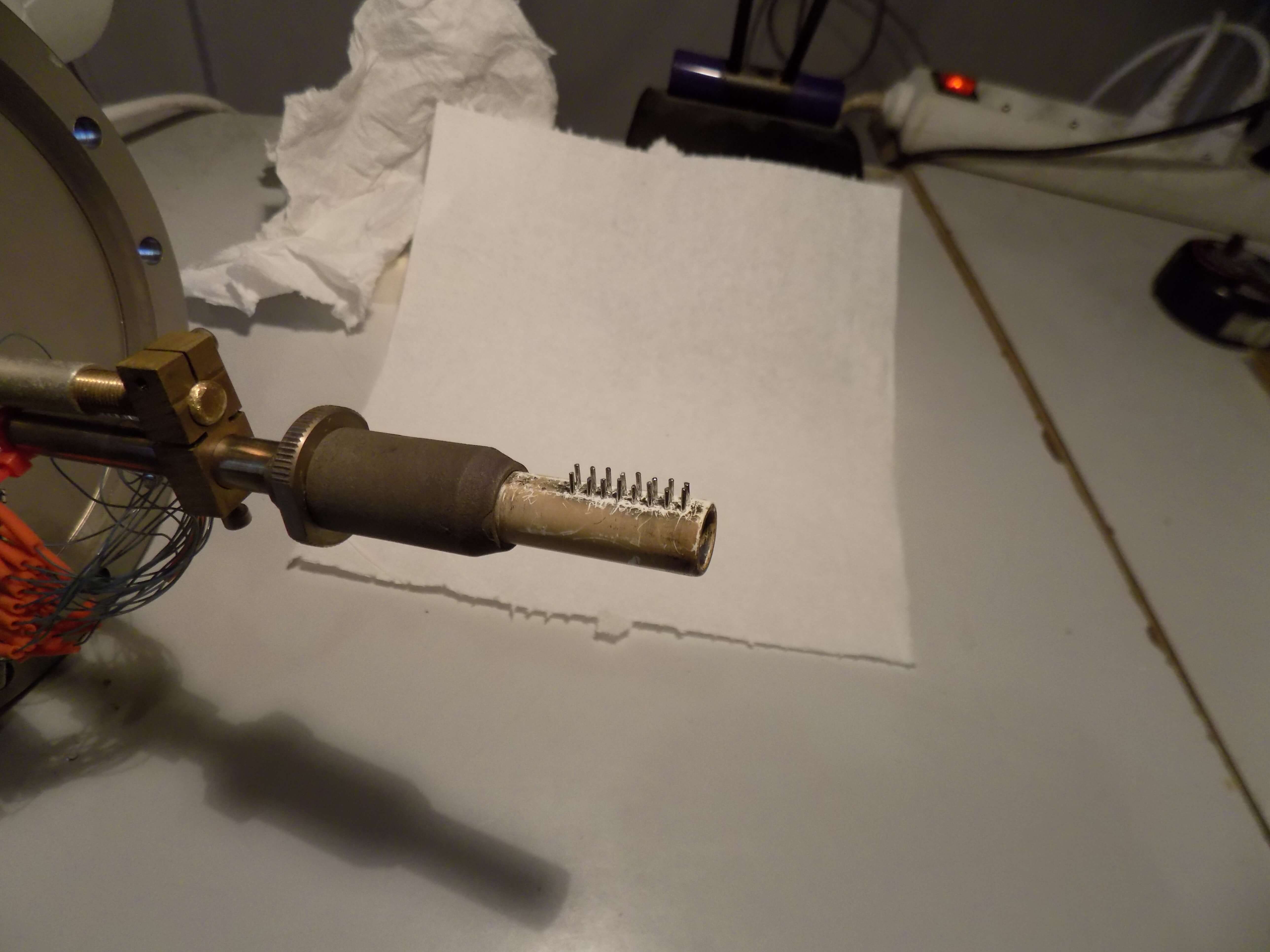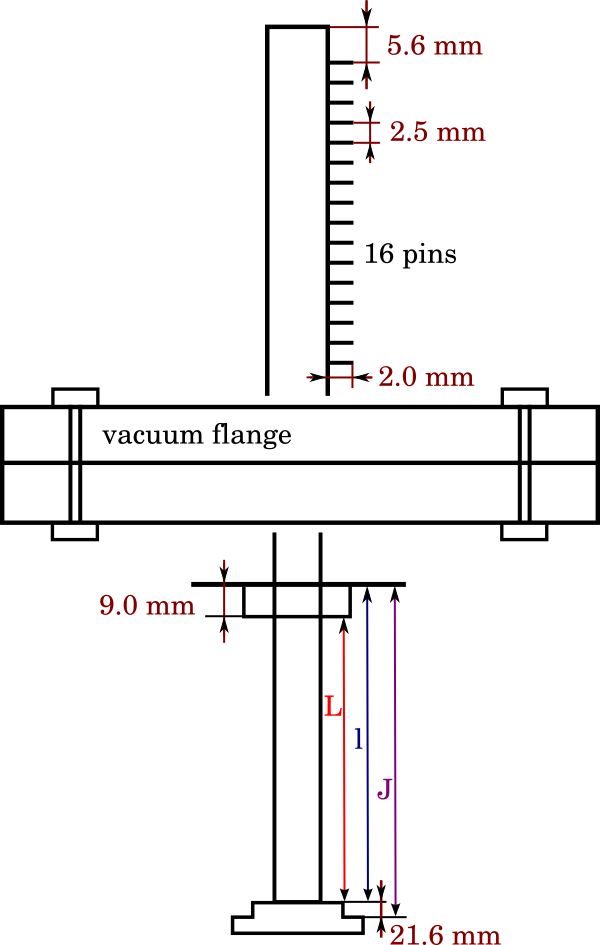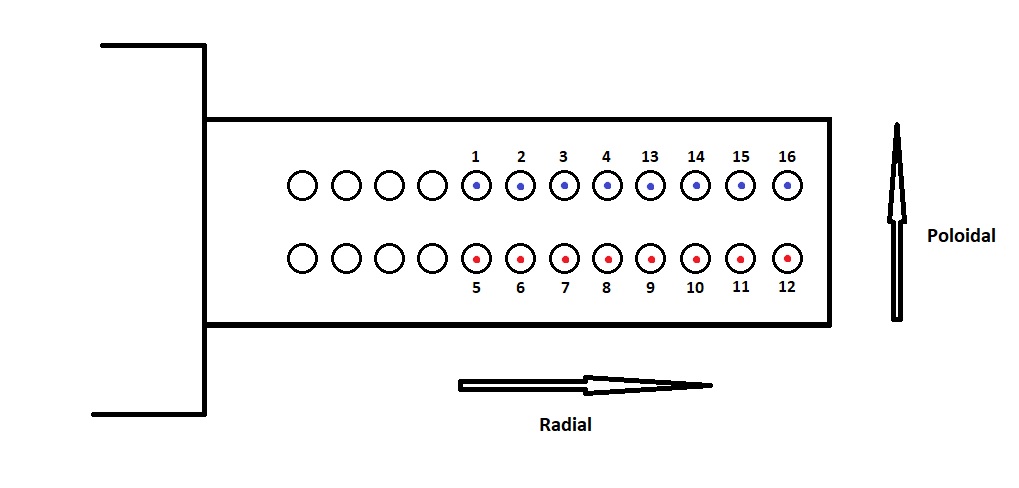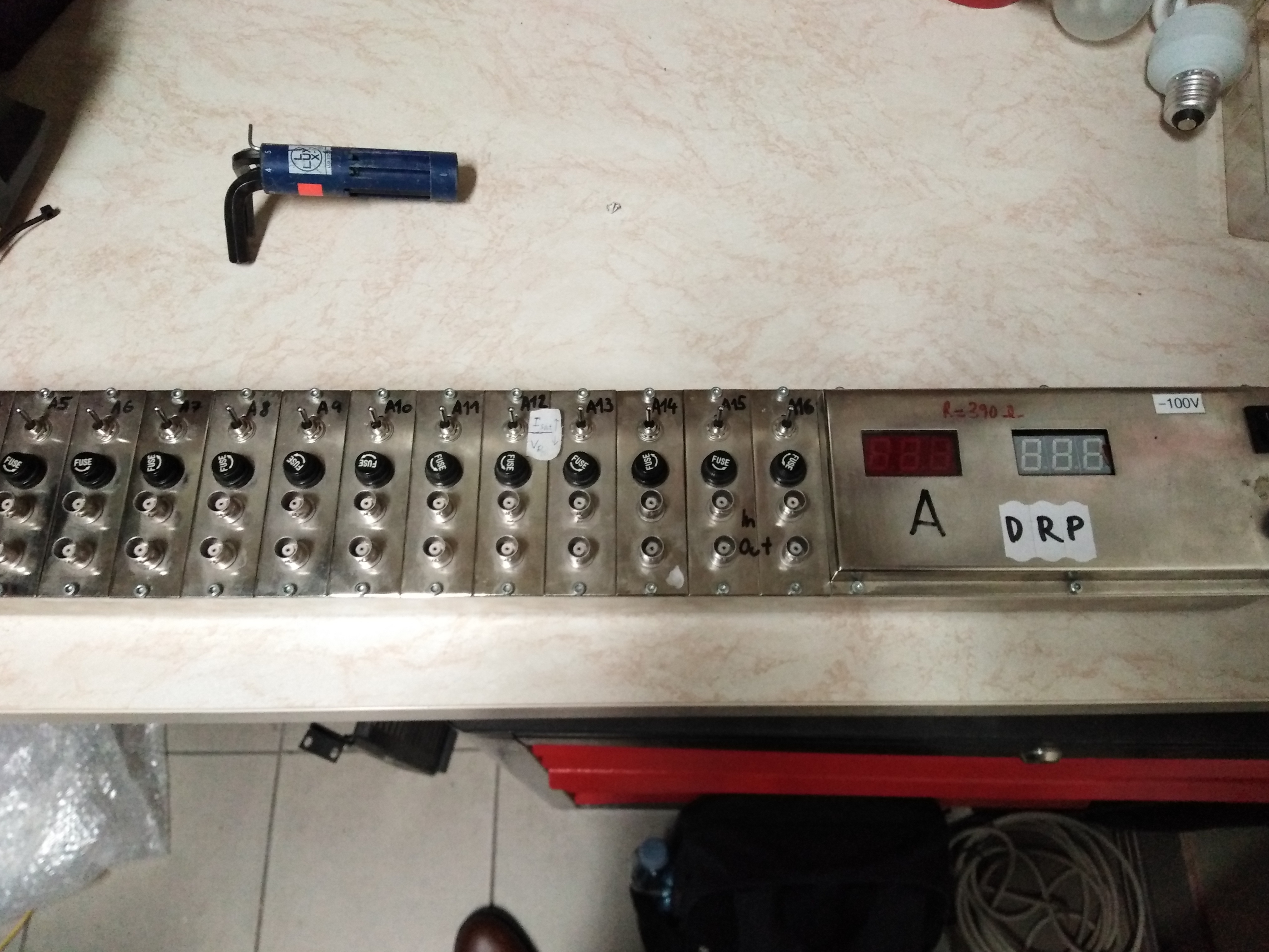Double rake probe
This page was last updated on 11 March 2021.
Introduction
The double rake probe (sometimes called just “rake probe”, but don’t confuse it with the single rake probe) is a probe head featuring 2x12 holes for pins and, currently, 2x8 pins, out of which 6+5 probes are connected into the data acquisition system. It allows for measurements of radial profiles of the ion saturated current \(I_{sat}\), floating potential \(V_{fl}\), and all the other quantities that Langmuir probes can measure.
The probe is currently installed at the south-east bottom port of the tokamak vessel. Its axis is slightly shifted in regard to the chamber centre, but the GOLEM plasma typically moves during the discharge anyway, so one can consider it to more or less plunge perpendicularly into the plasma.
Operation
Troubleshooting
The signal seems to be too small. Like if only noise is measured.
- Check that the pin you think is not working is connected to the DAS channel you think you are looking at. If it is, proceed further.
(This step includes checking from the first connector emerging from the vessel to the channel on the DAS.) - Check the corresponding fuse in the silver box. If it is not ok, replace the fuse with a functional one. If it is ok and there is still
no good signal, it might indicate a circuit break in the in-vessel part of the probe, which is rather a difficult problem to handle and might require the opening of the tokamak vessel.
Probe history
The most recent information is sorted first.
October 2019 - May 2020, probe head reconstruction
In October 2019 an extensive probe head reconstruction began. The reason for the reconstruction was the insufficient reliability of the probe, as some of the pins on the probe head stopped measuring for no apparent reason during a session. The problem was identified to be in the vacuum cables of the probe. Also, the pins installed in November 2018, made from actual pins, were not the best material for plasma applications.
It was planned to improve the reliability of the DRP in two ways. First was a replacement of the old cables with new ones and second, was the moving of the probe head to a new manipulator.
It was not necessary to change the cables, but it was inevitable to resolder the joints between the cables, the probe head and a D-SUB connector in a vacuum. However, such a complex reconstruction was exploited to the replacement. Currently, the cables are from the enamelled wire with a diameter of 0.22 mm. Also, the 25-pin D-SUB connector was replaced by two 9-pin D-SUB connectors to ease the movement of the vacuum cables in the narrow port space. The metallic part of the D-SUB connectors was removed to facilitate their movement even more. Regarding the two D-SUB connectors, it is necessary to mention that an ‘x’ mark was made on of the male/female pairs and it should always be connected this way to avoid misinterpretation of pin connection to the data channel. # picture of the ‘x’ mark on the D-SUB connector.
The next step of the reconstruction was the installation of new pins from molybdenum wire with a diameter of 0.75 mm, a new length of the pins is 1.5 mm, as the measured \(I_{sat}\) signal with 2mm pins was often too high. Before the pins were returned, the boron nitride shielding was abraded and thus cleaned.
The newly used manipulator has two important features that should improve probe reliability. The first feature is a slow translational movement that does not allow the cables to fully extend and get broken, also the setup of radial position is more precise. The second feature is the absence of rotational movement of the manipulator, i.e., once the probe is put into the chamber, the direction of the pins can not be changed. It also prevents violent overturning of the probe head resulting in broken cables.
Since discharge #33225 which was on 11.6.2020 a different connection of the pins and a new manipulator than before are used.
March 2019, change of pin connection
On 20 March 2019, Filip Papoušek (an FTTF student) took the probe out of the tokamak, measured all the pin contacts, and connected different pins into the data acquisition system. Now two rows of six pins are connected. He also screwed the probe a little tighter on the manipulator, which may have changed the accurate calculation of \(r\), see below.
| pin number according to this scheme | 16 | 15 | 14 | 13 | 4 | 3 | 12 | 11 | 10 | 9 | 8 | 7 | ||
|---|---|---|---|---|---|---|---|---|---|---|---|---|---|---|
| voltage source (numbered left to right) | 1 | 2 | 3 | 4 | 5 | 6 | 7 | 8 | 9 | 10 | 11 | 12 | ||
| DAS Papouch Zacek channel | 1 | 2 | 3 | 4 | 5 | 6 | 7 | 8 | 9 | 10 | 11 | 12 | ||
| temporary signal name ‘drppin’ | 01 | 02 | 03 | 04 | 13 | 14 | 15 | 16 | 09 | 10 | 11 | 12 | ||
| temporary signal name DRP | R1 | R2 | R3 | R4 | R5 | R6 | L1 | L2 | L3 | L4 | L5 | - | from discharge #33225 |
From 20 to 27 March 2019, the pins were connected according to the table above. On 27 March 2019 between shots #30138 and #30139, the signal names were updated so that the signal name corresponds to the correct pin number.
As a part of the reconstruction, new names were assigned to the pins in the DAS of GOLEM, current (since June 2020) names can be seen here.
November 2018, exchange of probe pins
In November 2018, Sergei Kulkov (an FTTF student) took the probe out of the tokamak, removed all the pins due to their bending and unequal lengths and replaced 16 of them with new pins. His session notes may be found here. Due to this, older records of the double rake probe feature 24 pins, while the current probe only has 16. Don’t be confused, they are one and the same.
Geometry
Marked on the manipulator photo:
- pink circle: clip that prevents the manipulator from sliding inside the chamber when the probe is fully drawn out
- blue circles: a pen mark and a small screw, denoting the direction of the probe pins
- yellow arrow: \(r_0\) is measured here
The distance of the first pin from the chamber centre, \(r\), can be calculated from the distance \(r_0\) denoted on the manipulator photo above as
\(r = r_0 - 7.5\) mm
This formula was derived based on measurements performed by Filip Papoušek, and so it is currently considered accurate. Before Filip’s manipulation with the probe (see above), the formula used was
\(r = J - 3.16\) cm
based on the scheme above. It was never confirmed, however, how accurate it was. __Since June 2020 the depth of the deepest pin can be deducted directly on the probe manipulator. The position of the deepest pin on the right side, when one is looking at the probe head towards the pins, is also stored in the GOLEM shot database as r_DoubleRakeProbeUpperPinRadialPosition. As the probe head is not centred with the vacuum chamber but rather shifted to the LFS by 13.5 (right rake) and 16 mm (left rake) from the centre of the port (and thus the vacuum chamber).
Support equipment
The so-called “silver box” is a part of the experimental setup of the double-rake probe. See silver box for more information.
Reports
- Filip Papoušek (Research project 19/20): Systematic study of impact of swept edge plasma potential biasing on turbulence in tokamaks
- Kateřina Jiráková (PRPL 15/16): Turbulentní transport v SOL tokamaku GOLEM: Srovnání s tokamakem COMPASS
- Ondřej Grover (PRPL 15/16): Reynolds stress measurements with double rake probe
- Sergei Kulkov (PRPL 18/19-19/20): Plasma fluctuation measurements with the double rake probe
#Literature * V. Svoboda et al, Remote operation of the GOLEM tokamak with hydrogen and helium plasmas * J. Brotánková et al, Measurement of Sheared Flows in the Edge Plasma of the CASTOR Tokamak, Plasma Physics Reports 35/11 (2009), 980–986 * P. Devynck et al, Dynamics of turbulent transport in the scrape-off layer of the CASTOR tokamak, Physics of Plasmas 13, 102505 (2006)










